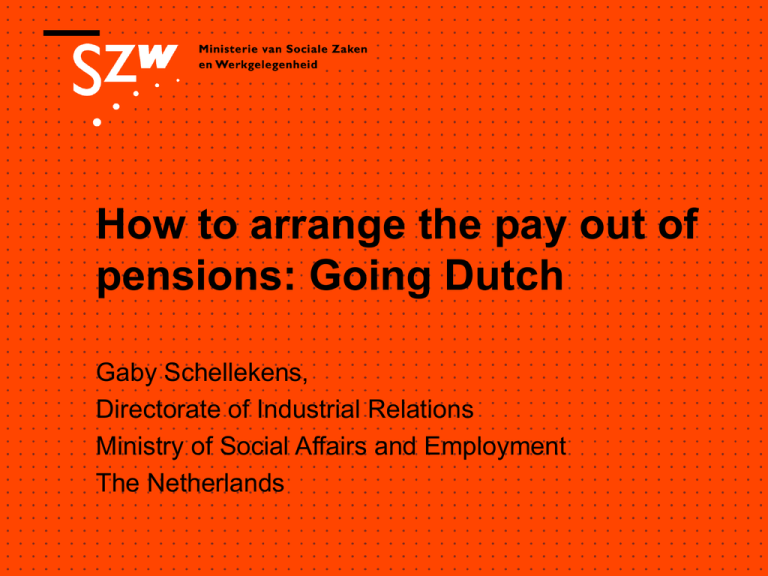How to arrange the pay out of pensions Going Dutch
advertisement

How to arrange the pay out of pensions: Going Dutch Gaby Schellekens, Directorate of Industrial Relations Ministry of Social Affairs and Employment The Netherlands Dutch three pillar pension system 1. State pension 2. Occupational pension schemes 3. Individual insurance arrangements 1st pillar 2nd pillar 3rd pillar Second pillar: Occupational pension schemes > 90% of the employees in the Netherlands are member of an occupational pension scheme Fully funded schemes Contributions tax deductible, benefits taxed Occupational pension schemes • Agreed upon between employer and employee, or between social partners • Three possible types of pension schemes: Benefit agreement (= DB) Premium agreement (=DC) Capital agreement • Transparency for the scheme member Benefit agreement (=DB) • Agreement on a pension scheme in which the benefit is set. • The height of the benefit normally depends on salary and/or period of service • Longevity and investment risk belong to the pension provider Premium agreement (=DC) • Agreement on a pension scheme in which the premium is set • There are three options: 1. Premium is invested till pension age: longevity risk and investment risk for the employee 2. Premium is converted in a claim to a capital sum right away: investment risk for the pension provider, l ongevity risk for the employee 3. Premium is converted right away in a claim to a pension benefit:longevity risk and investment risk for the pension provider Capital agreement • Agreement on a pension scheme in which a capital sum at pension age is set • The height of the capital depends on period of service • Investment risk belongs to the pension provider, longevity risk belongs to the employee (firstly at the moment of conversion of the capital sum into a periodic benefit the rates are known) Inflation: Who bears the Risk? • Depends on the kind of agreement: - in benefit agreement normally the pension provider, - in premium and capital agreements normally the employee • But it also depends on the indexation clause of the pension scheme: - no legal obligation to index - part of the scheme rules Pay-out products in the Dutch second pillar • The Pension Act dictates an old age pension scheme to deliver lifelasting, fixed, benefits • Therefore every possible type of scheme (either benefit, premium or capital agreement) has to pay out lifelasting annuities • So in the pay-out phase the investment and longevity risk belong to the pension provider Pension market • Legal obligation to put pension capital outside the company • Three possibilities: - Industry-wide pension fund - Company pension funds - Life-insurance contract • Participation in industry-wide pension fund can be made mandatory Pension market • Pension annuities are provided for by either a pension fund, or by a life insurance company. (Depends on what is agreed upon between social partners) • In the Netherlands there is a strong common opinion that pension arrangements based on collectivity and solidairity can realize a higher level of economic prosperity than individual arrangements Pension market Collective pension arrangements have large economic advantages: • Investment risks can be spread between generations of pension scheme members • Relatively low administrative costs • Money can be spent only once, people themselves probably do not choose to spend it on individual pension arrangements Pension market Disadvantages of collective pension schemes: • No tailor made solutions • Lack of individual choice But in the Netherlands we feel that the advantages of collective arrangements exceed the disadvantages Future “challenges” for the Dutch second pillar • Ageing of the population • Worldwide trend to more individualization and freedom of choice • International legislation relating to the field of pensions International rules: IAS/IFRS • IAS leads to a shift from defined-benefit to defined-contribution occupational pensions. • In the Netherlands this has resulted in a specific answer: the collective defined contribution system (CDC), which is characterized by properties of both DB and DC. Collective defined contribution system (CDC) • DC-element: contribution paid by the employer is fixed during a certain period, in practice for a minimum period of 5 years. • DB-element: annual accrual of pension rights is based on average or final pay. Collective defined contribution system (CDC) • If the contributions are insufficient to finance the annual accrual, accrual will be lowered accordingly. • Financial investments and risks related to the pension scheme are still met in the pension fund on the basis of solidarity and collectivity. Not sure yet whether CDC will be a sustainable answer to IAS in the view of accountants Future “challenges” for the Dutch second pillar • Pension systems in the EU very different, but all have the same goal • “No-one-best-way” to secure the income position of retirees Dutch wish for the future • Recognizing all those possible ways to insure a decent income for the elderly should play an important role in the process of designing international rules in the field of pensions. • International legislation must reach the intended purposes, but the good elements of the different national pension systems should not be threatened. Thank you for your attention ?





